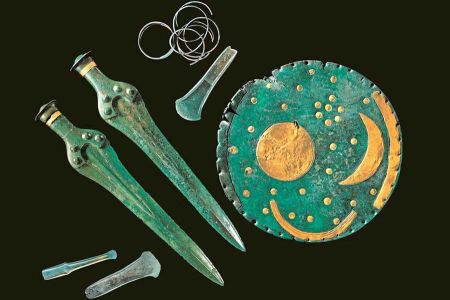Nebra Sky Disc - 100 million insurance value
- Written by Portal Editor
The thriller about the Nebra Sky Disc still never ends. It was initially the tense story about the professional robbery of the artefacts after the sky disc was found on July 4th, 1999 on the Mittelberg in the former municipality of Ziegelroda near the city of Nebra in Saxony-Anhalt, now it's the analyses of the actual age the sky disc that excite the mind.
But first some facts: The sky disc had been "found" by the two robbers Henry Westphal and Mario Renner, who initially believed that their finding was the middle part of a shield. The illegally acting probe users searched with a metal detector, which suggested professional robbery. Just one day after the objects were excavated, Westphal and Renner got 31,000 DM from a Cologne dealer for the entire find, including two bronze swords, two axes, a chisel and fragments of spiral bracelets. The artefacts were then to be sold through various middlemen in 1999, initially in Berlin, and later in Munich for one million DM.
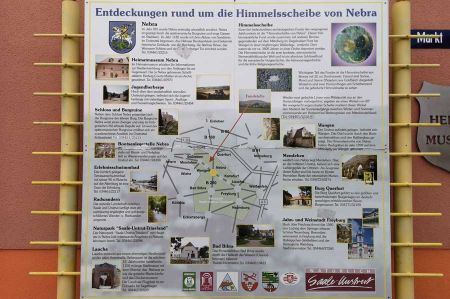 In the meantime, however, word had got around that the sky disc rightfully belonged to the state of Saxony-Anhalt. In Saxony-Anhalt there is Section 12 (1) Monument Protection Act SA, according to which archaeological finds become the property of the state where they are discovered. This made it worthless for the serious art trade. The entire find changed hands several times up to 2001, most recently for over 200,000 DM to a fence couple, a museum educator, and a teacher.
In the meantime, however, word had got around that the sky disc rightfully belonged to the state of Saxony-Anhalt. In Saxony-Anhalt there is Section 12 (1) Monument Protection Act SA, according to which archaeological finds become the property of the state where they are discovered. This made it worthless for the serious art trade. The entire find changed hands several times up to 2001, most recently for over 200,000 DM to a fence couple, a museum educator, and a teacher.
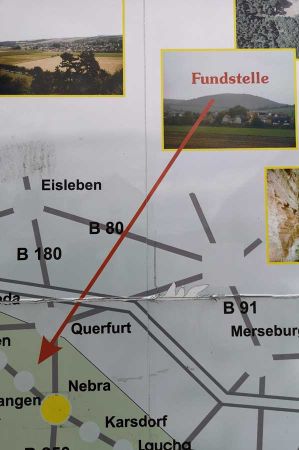 On the initiative of the Ministry of Culture and the Ministry of the Interior as well as the State Office for Archaeology of Saxony-Anhalt, contact was made to the couple with the stolen goods who had offered the disc for 700,000 DM on the black market. The state archaeologist Harald Meller met on February 23, 2002 as a supposed buyer with the fence couple in a hotel in Basel. The Swiss police seized the sky disk there. The involved people were arrested, the accompanying finds secured, and the robbery graves were captured, too. They provided information on the location that could be confirmed by forensic investigations.
On the initiative of the Ministry of Culture and the Ministry of the Interior as well as the State Office for Archaeology of Saxony-Anhalt, contact was made to the couple with the stolen goods who had offered the disc for 700,000 DM on the black market. The state archaeologist Harald Meller met on February 23, 2002 as a supposed buyer with the fence couple in a hotel in Basel. The Swiss police seized the sky disk there. The involved people were arrested, the accompanying finds secured, and the robbery graves were captured, too. They provided information on the location that could be confirmed by forensic investigations.
The value of the sky disc is priceless; their insurance value in 2006 was 100 million euros.
The Nebra Sky Disc is a 3700 to 4100-year-old, circular bronze plate with gold applications, making it the oldest known concrete representation of the sky.
About the Nebra Sky Disc
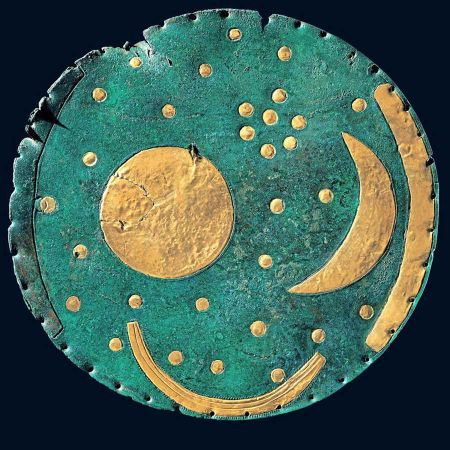 The artifact of the so-called Aunjetitz culture from the early Bronze Age in Central Europe shows astronomical phenomena and religious symbols. Gold invalidation, which was incorporated a long time after the creation, and the presumably deliberate burial about 3600 years ago, allow the conclusion to be drawn to a longer, possibly religious use. The Nebra Sky Disc has been part of the State Museum for Prehistory of Saxony-Anhalt in Halle since 2002 and has been a UNESCO World Heritage Site in Germany since June 2013.
The artifact of the so-called Aunjetitz culture from the early Bronze Age in Central Europe shows astronomical phenomena and religious symbols. Gold invalidation, which was incorporated a long time after the creation, and the presumably deliberate burial about 3600 years ago, allow the conclusion to be drawn to a longer, possibly religious use. The Nebra Sky Disc has been part of the State Museum for Prehistory of Saxony-Anhalt in Halle since 2002 and has been a UNESCO World Heritage Site in Germany since June 2013.
The applications made of unalloyed gold sheet are made using insert technology and have been supplemented and changed several times. Based on the accompanying finds already described, it can be assumed that they were around 1600 BC. Its manufacturing date is dated to 2100 to 1700 BC.
Togetherness of the finds
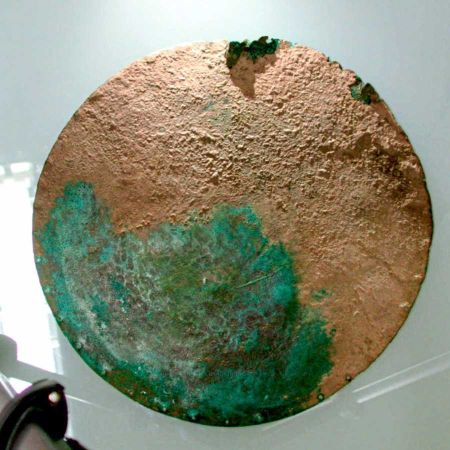 In order to check the statements of the robbers that all objects found came from the same deposit and from the specified location on Mittelberg, the State Office for Monument Preservation and Archaeology in Halle commissioned the State Criminal Police Office of Brandenburg to prepare an expert opinion in 2003. In the investigation carried out by Jörg Adam, a soil sample from the presumed location was compared with soil adhering to the sky disc. A little later, comparisons were also made with soil adherence to one of the swords and one of the axes. In addition, Adam carried out a comparison with soil samples from other locations, which, similar to the Mittelberg, are characterized by red sandstone lying on the surface. He found that the soil sample and the build up on the sky disc and the sword matched largely or completely. Both could therefore be assigned to the site on Mittelberg with a very high degree of probability. In contrast, Adam noticed some deviations in the composition of the adhesions on the axe, but still considered an origin from Mittelberg to be possible.
In order to check the statements of the robbers that all objects found came from the same deposit and from the specified location on Mittelberg, the State Office for Monument Preservation and Archaeology in Halle commissioned the State Criminal Police Office of Brandenburg to prepare an expert opinion in 2003. In the investigation carried out by Jörg Adam, a soil sample from the presumed location was compared with soil adhering to the sky disc. A little later, comparisons were also made with soil adherence to one of the swords and one of the axes. In addition, Adam carried out a comparison with soil samples from other locations, which, similar to the Mittelberg, are characterized by red sandstone lying on the surface. He found that the soil sample and the build up on the sky disc and the sword matched largely or completely. Both could therefore be assigned to the site on Mittelberg with a very high degree of probability. In contrast, Adam noticed some deviations in the composition of the adhesions on the axe, but still considered an origin from Mittelberg to be possible.
The similarity of the processed material of all finds is further evidence of the connection between the bronze pieces. The copper used for all bronze parts shows similar concentrations of trace elements in all Nebra finds, only the content of different lead isotopes varies relatively strongly.
New discussions about the age of the sky disc
In September 2020, the two researchers Rupert Gebhard and Rüdiger Krause published a controversial reassessment, according to which the disk should not come from the early Bronze Age, but rather from the Iron Age (approx. 800 to 50 BC). After analysing the context of the find, they saw no convincing evidence that the artefacts found together with the disk and undisputedly from the Bronze Age would form an ensemble belonging to the disk. Gebhard and Krause also pointed out similarities between the sky disc and pictorial motifs from the Iron Age. THeir main criticism was directed against the state archaeologist of Saxony-Anhalt, Harald Meller, who had previously covered up the deficits in evidence with skilful rhetoric. The new hypothesis aroused wide media coverage and was immediately and decisively rejected by the State Office for Monument Preservation and Archaeology of Saxony-Anhalt.
Gebhard and Krause refer, among other things, to the investigations carried out by Jörg Adam of soil samples and soil deposits, which, according to their interpretation, speak against the belonging together of the objects. According to Meller's reply, they reproduced some of Adam's statements in abbreviated form and failed to mention contrary findings from Adam's research report.
In November 2020, a 13-person research group led by Ernst Pernicka from the Curt Engelhorn Centre for Archaeometry in Mannheim disputed doubts about the previous dating of the sky disk in a study published in the journal Archaeologic Austriaca of the Austrian Academy of Sciences (ÖAW), including the authors Jörg Adam heard clearly back. Gebhard and Krause argued in September with incomplete and partly incorrect or falsified data. In addition to the radiocarbon dating, the old age of the disc is also supported by the known deposits of the metals used in the manufacture of the sky disc and the gold and copper concentrations proven at the clearly identifiable location in the surrounding soil. The image motif, namely the representation of a ship on the artifact, is also typical of the Bronze Age.
Please read as well:
By bike to the healthy sources of Bad Bibra
With E-Bike to 12-Apostel bridge near Bad Bibra
